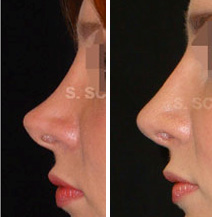

High forehead, striking eyes, full lips and black hair: the typical Mediterranean beauty. The target for the nose can only be a finely projected tip, not too upturned and not unduly narrowed, with a clearly defined ridge and no concavity.
Primary Rhinoplasty: pre and post-operative images.
The "natural" nose
"Doctor I do not want the classic nose job that has obviously been operated on! I want the most natural possible nose"
This is the first phrase that every nasal surgeon hears from patients looking for a rhinoplasty. So, what is this "natural" nose?
In the 60's and 70's every girl wanted the French turned-up nose. Not anymore: a feminine nose but without excesses is generally desired, with a pretty tip but not too thin, one that improves the overall appearance of the face without distorting it.
Men prefer a straight nose, without a hump or other imperfections, maintaining a masculine appearance.
An ideal nose that has characteristics that suit everyone cannot be defined: the ideal nose is that which adapts best to the overall conformation of the face. For this reason the surgeon, before undertaking a rhinoplasty, studies all the various components and proportions of the face, skin type, gestures and dynamics of the nose and respiratory function.
Computer simulation of possible results, always carried out during the examination, proves immensely useful in the phase of preoperative study. This helps the patient to understand what can and cannot be obtained and gives the surgeon an idea of the patient’s expectations. While it does not show the patient exactly what he or she will look like after the operation, it does set the surgeon a target to aim at.
The "french" nose
 This young lady was operated on approximately 10 years previously.
This young lady was operated on approximately 10 years previously.
The initial result seemed pretty but as time gone on appeared more and more displeasing being too unnatural and artificial. The appearance was that of the classic "nose job". Her wish was to return to having a natural nose, straight, and in harmony with her face. The surgery had to succeed therefore in carrying out two fundamental corrections: first to correct the profile of the over-flattened bridge of the nose. This was achieved with grafts of cartilage taken from the patient's septum, fortunately still intact.
The second correction was much more difficult than the first: it was necessary to rotate the tip downwards to correct the exagerated "turned-up" appearance of the nose.
An extension graft was arranged in such a way to push the alar cartilages of the tip downwards. The appearance achieved is that of a beautiful nose, without excesses, adapted to the face and "absolutely natural".
A complex secondary rhinoplasty
Female, 24 years old, already operated on 3 times: the first an unsuccessful rhinoplasty, then two subsequent attempts to improve the original surgery, also unsuccessful. The structures that supported the nose, in particular the cartilages, appeared irreparably damaged: the nose was supported only by amorphous scar tissue that gave neither support nor definition to the tip, and had become shapeless. The bridge was too carved resulting in a "saddle nose". The nose had a negative effect on her appearance. The entire structure of the nose had to be reconstructed with grafts: but which?
A malleable but at the same time rigid material was required, otherwise in the post-operative scarring contraction it would have folded or moved ruining the result. Moreover an abundant amount was needed, in order to reconstruct nearly all of the nasal structures.
The logical choice was rib cartilage from the patient herself: abundant, rigid, malleable, and above all perfectly biocompatible. The photos before and approximately 10 months after the secondary rhinoplasty surgery: even though the swelling will go down a little more the result can be considered definitive and stable.

Click here to see other pre- and post-operatory photographs

A modification of the profile in order to obtain a curve
just noticeable that the appearance does not undermine
the face: the hump is no longer there but the nose retains
a natural appearance.
Primary Rhinoplasty: pre and post-operative images.
 A nasal tip without definition and correct projection is a sign of
A nasal tip without definition and correct projection is a sign of
an unsuccessful rhinoplasty.
Images pre and post-operative:
Left after the first operation, right after the secondary rhinoplasty.

Nasal bridge too grooved (saddle nose) gives an unnatural and
unpleasant appearance especially to a male profile.
Pre and post-operative images of secondary rhinoplasty.

The modifications are small and the surgery has been done
with a "light" hand: a slight retouch to the tip and a light lowering
of the bridge. The nose remains natural but the overall change
is obvious and pleasing.
Primary Rhinoplasty: pre and post-operative images.